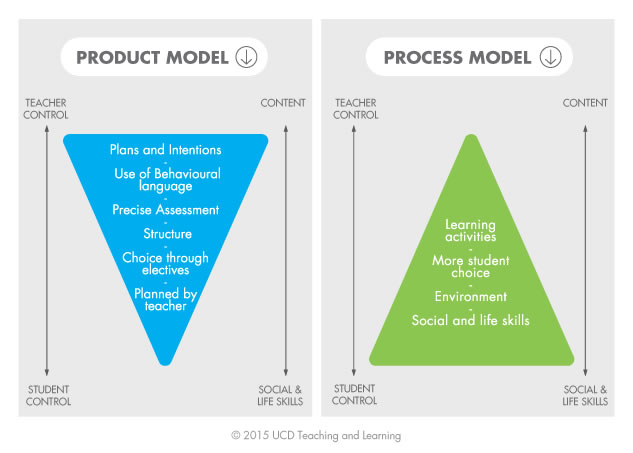Curriculum models are models that help curriculum designers to systematically and transparently map out the rationale for the use of particular teaching, learning and assessment approaches. Curriculum models help stress the importance that different courses should build on each other.
Students acquire content knowledge and master the main skills step-by-step in the consecutive courses of the curriculum. These developments of students can be described with help of learning pathways for the main skills and the main content knowledge. Each curricular learning pathway can be made explicit with help of a schematic model, showing the steps in the learning process of the courses involved.
Getting started
Step 1. Choose a suitable curriculum model
In general, curriculum models can be divided in product models and process models:

Product models develop and communicate transparent outcomes to the student populations and move emphasis away from lists of content. Recent literature in this area suggests that in using this model, care should be taken not to be overly prescriptive when writing learning outcomes (Gosling, 2009; Hussey & Smith, 2008; Maher, 2004). Examples of product models are competency-based curricula and theme-based curricula.
Process models start planning a curriculum with defining the processes, messages and conditions of the curriculum and trusts that good outcomes will follow. Examples of process models are negotiated curriculum models and problem-based models.
Identifying and being consistent with these models will help support cohesion and clarity of approaches in your programme.
Step 2. Apply the model to designing a curriculum
Independent from the choice of model, six quality criteria should be met when (re)designing a curriculum (Berkvens, Van den Akker & Brugman, 2014):
- Relevance: the curriculum is based on up-to-date academic knowledge and understanding of contextual need;
- Consistency: the structure of the curriculum is logical and coherent;
- Practicality: the curriculum is usable in the context it is designed for;
- Effectiveness: the curriculum leads to the desired outcomes;
- Scalability: the curriculum is successfully adaptable to different numbers of students;
- Sustainability: the curriculum remains useable over extended periods of time.
Further reading
O’Neill, G. (2015) Curriculum Design in Higher Education: Theory to Practice, Dublin: UCD Teaching and Learning.
References
- Berkvens J,. Van den Akker J, Brugman M (2014). Addressing the Quality Challenge: Reflections on the Post-2015 UNESCO Education Agenda. Netherlands: Netherlands National Commission for UNESCO.
- Dearn, J.M. (2010) Innovation in Teaching and Curriculum Design. International Encyclopedia of Education. Gale Virtual Reference Library (GVRL). Available online 14 May 2010.
- Diamons, R.M. (1998) Designing and assessing courses and curricula. A practical guide. Second edition. Jossey-Bass Publishers: San Francisco
- Gosling, D. (2009). Academic development identity and positionality. SRHE Academic Development Network Paper (London: SRHE).
- Verloop, N. en Lowyyck, J. (2003) Onderwijskunde Wolters Noordhoff.
- Hussey, T., & Smith, P. (2008). Learning outcomes: a conceptual analysis. Teaching in higher education, 13(1), 107-115.
- Maher, A. (2004). Learning outcomes in higher education: Implications for curriculum design and student learning. Journal of Hospitality, Leisure, Sport and Tourism Education, 3(2), 46-54.
